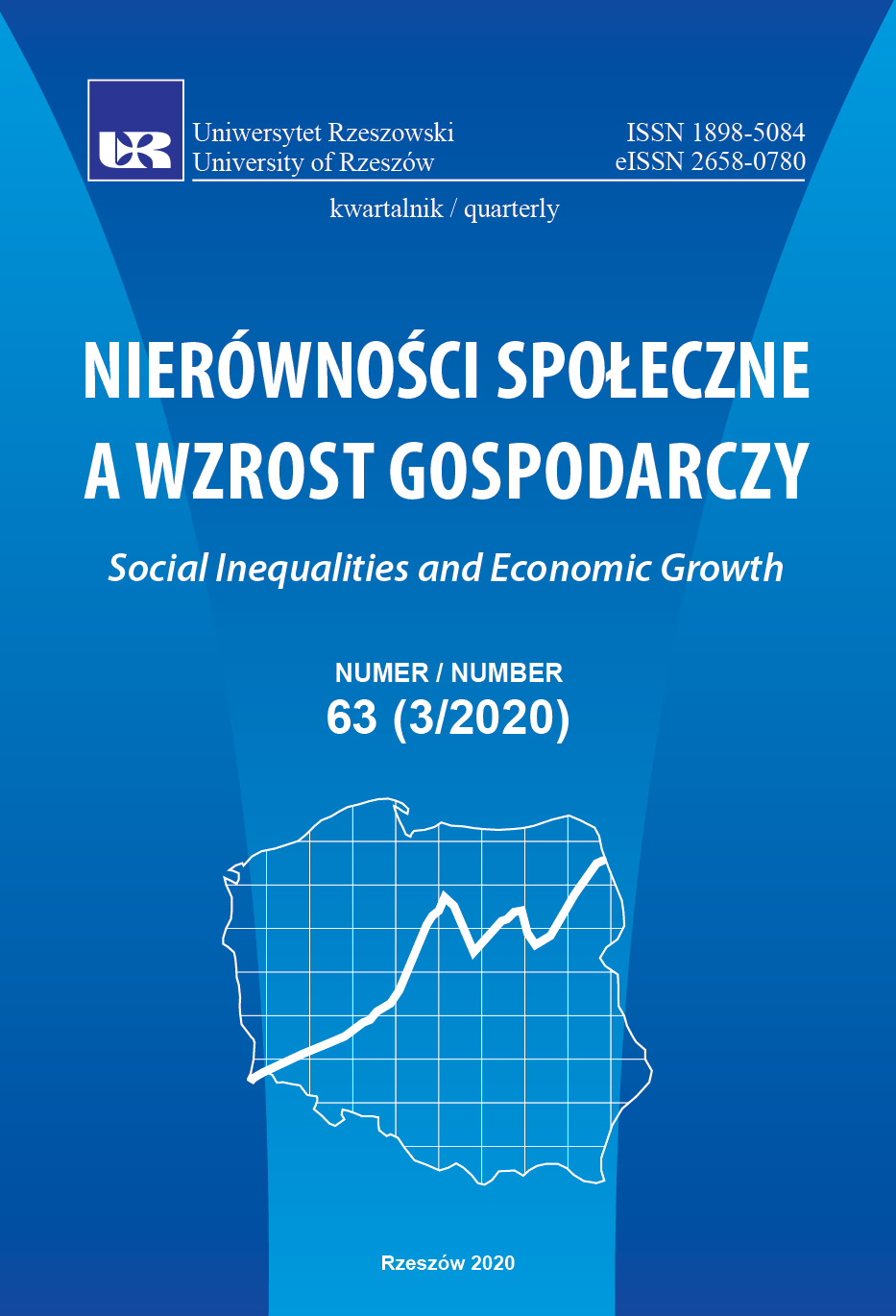Regionalna analiza ubóstwa i mobilności gospodarstw domowych ‒ podejście oparte na prawdopodobieństwie przejścia
DOI:
https://doi.org/10.15584/nsawg.2020.3.15Słowa kluczowe:
ubóstwo, prawdopodobieństwa przejścia, łańcuchy Markowa, mobilność, nierówności, analiza regionalnaAbstrakt
Głównym celem niniejszego artykułu była próba estymacji i analizy macierzy prawdopodobieństw przejścia, określonej dla wszystkich szesnastu regionów Polski (województwa, poziom NUTS-2). Analiza została przeprowadzona pod kątem przejść pomiędzy sześcioma klasami wydatków (w ujęciu per capita oraz na jednostkę ekwiwalentną), ze szczególnym uwzględnieniem sfery ubóstwa. Okres analizy obejmował dwa lata: rok 2015 oraz 2016. Podstawowe pytanie dotyczyło tego, w których regionach prawdopodobieństwo pozostawania w biedzie jest największe oraz jaki jest ogólny poziom mobilności pomiędzy klasami wydatków. Do badania została wykorzystana dwuletnia podpróba panelowa oparta o nieidentyfikowalne dane jednostkowe Głównego Urzędu Statystycznego, pochodzące z badania budżetów gospodarstw domowych. W badaniu wykorzystano zarówno wydatki per capita, jak i wydatki na jednostkę ekwiwalentną, aby wziąć pod uwagę różnice w wielkości i strukturze demograficznej gospodarstw domowych. Elementy macierzy przejścia były szacowane za pomocą klasycznego estymatora największej wiarygodności. Analiza została uzupełniona ogólną oceną mobilności za pomocą indeksów mobilności Shorrocksa i Bartholomewa oraz oceną poziomu nierówności wydatków za pomocą indeksu Giniego. Wyniki pokazały, że roczne prawdopodobieństwa pozostawania w biedzie różnią się w zależności od regionu i są mniejsze dla wydatków na jednostkę ekwiwalentną. Największe prawdopodobieństwo zaobserwowano dla województwa podkarpackiego (wydatki per capita) oraz opolskiego (wydatki na jednostkę ekwiwalentną). Najniższym prawdopodobieństwem odznaczało się województwo kujawsko-pomorskie (wydatki per capita) oraz małopolskie (wydatki na jednostkę ekwiwalentną). Najwyższym ogólnym poziomem mobilności charakteryzowało się województwo małopolskie (dla obu kategorii wydatków).
Downloads
Bibliografia
Alkire, S., Apablaza, M. (2016). Multidimensional poverty in Europe 2006–2012: Illustrating a methodology. OPHI Working Paper, 74, 1–22.
Atkinson, A. B. (1987). On the measurement of poverty. Econometrica, 55(4), 749‒764. DOI: 10.2307/1911028.
Atkinson, A. B. (2019). Measuring poverty around the world. New Jersey: Princeton University Press. DOI: 10.1515/9780691191898.
Bartholomew, D. J. (1973). Stochastic Models for Social Processes. London: J. Wiley and Sons. DOI: 10.1002/bimj.19740160813.
Bieńkuńska, A. (2013). Multidimensional poverty and social isolation in Poland. Working Paper, 20, 1–14.
Corak, M. (2013). Income inequality, equality of opportunity, and intergenerational mobility. Journal of Economic Perspectives, 27(3), 79–102. DOI: 10.1257/jep.27.3.79.
CSO (2016). Household budget survey in 2015. Warsaw: Central Statistical Office.
CSO (2017). Household budget survey in 2016. Warsaw: Central Statistical Office.
CSO (2019). Local data bank. Retrieved from: https://bdl.stat.gov.pl/BDL/start (2019.6.06).
Czajkowski, A. (2009). Forecasting income distributions of households in Poland on the basis of Markov chains. Acta Universitatis Lodziensis, 225, 245‒256.
Edigarian, E., Kościelniak, P., Trojak, M. (2013). Analiza zróżnicowania rozwoju ekonomicznego województw i powiatów oparta na łańcuchach Markowa. In: M. Trojak, T. Tokarski (Eds.), Statystyczna analiza przestrzennego zróżnicowania rozwoju ekonomicznego i społecznego Polski (pp. 111‒128). Kraków: Wydawnictwo Uniwersytetu Jagiellońskiego.
Eurobarometer (2010). Poverty and social exclusion. Special Eurobarometer, 321. Retrieved from: https://ec.europa.eu/commfrontoffice/publicopinion/archives/ebs/ebs_321_ en.pdf (2019.06.06).
Haughton, J., Khandker, S. R. (2009). Handbook on poverty and inequality. Washington D.C.: World Bank. DOI: 10.1596/978-0-8213-7613-3.
Górajski, M., Serwa, D., Wośko, Z. (2016). Measuring expected time to default under stress conditions for corporate loans. NBP Working Paper, 237, 1–36.
Jędrzejczak, A. (2011). Metody analizy rozkładów dochodów i ich koncentracji. Łódź: Wydawnictwo Uniwersytetu Łódzkiego.
Kordos, J. (1973). Metody analizy i prognozowania rozkładów płac i dochodów ludności. Warszawa: Państwowe Wydawnictwo Ekonomiczne.
Kot, S. M. (2000). Ekonometryczne modele dobrobytu. Warszawa–Kraków: Wydawnictwo Naukowe PWN.
Kot, S. M. (2004). Rozkłady dochodów, nierówności i dobrobyt w Polsce. In: S. M. Kot, A. Malawski, A. Węgrzecki (Eds.), Dobrobyt społeczny, nierówności i sprawiedliwość dystrybutywna (pp. 248‒280). Kraków: Wydawnictwo Akademii Ekonomicznej w Krakowie.
Narayan, A., Van der Weide, R., Cojocaru, A., Lakner, C., Redaelli, S., Mahler, D. G., The- wissen, S. (2018). Fair progress?: Economic mobility across generations around the world. Equity and development. Washington D.C.: World Bank. DOI: 10.1596/978-1-4648-1210-1.
Panek, T. (2014). Ubóstwo i wykluczenie społeczne. In: T. Panek (Ed.), Statystyka społeczna (pp. 195‒239). Warszawa: Polskie Wydawnictwo Ekonomiczne.
Quah, D. T. (1995a). Aggregate and regional disaggregate fluctuations. Centre for Economic Performance Discussion Paper No. 275.
Quah, D. T. (1995b). Empirics for economic growth and convergence. Centre for Economic Performance Discussion Paper No. 253.
Rey, S. (2014). Rank-based Markov chains for regional income distributions dynamics. Journal of Geographical Systems, 16(2), 115‒137. DOI: 10.1007/s10109-013-0189-0.
Sen, A. K. (1981). Poverty and famines: An essay on entitlement and deprivation. Oxford: Clarendon Press. DOI: 10.5040/9781474220156.ch-005.
Shorrocks, A. F. (1976). Income mobility and the Markov assumption. The Economic Journal, 86(343), 566‒578. DOI: 10.2307/2230800.
Shorrocks, A. F. (1978). The measurement of mobility. Econometrica, 46(5), 1013‒1024. DOI: 10.2307/1911433.
World Bank (2005). Introduction to poverty analysis. World Bank Institute. Retrieved from: http://siteresources.worldbank.org/PGLP/Resources/PovertyManual.pdf (2019.06.15).
World Bank (2018). Poverty. Retrieved from: https://www.worldbank.org/en/topic/poverty (2019.08.18).
Pobrania
Opublikowane
Jak cytować
Numer
Dział
Licencja
Prawa autorskie (c) 2020 Uniwersytet Rzeszowski

Utwór dostępny jest na licencji Creative Commons Uznanie autorstwa – Na tych samych warunkach 4.0 Miedzynarodowe.


